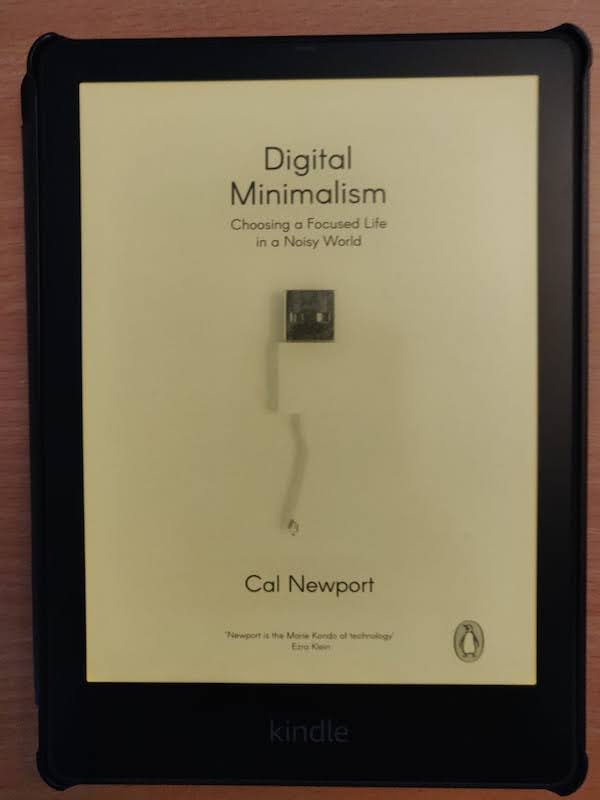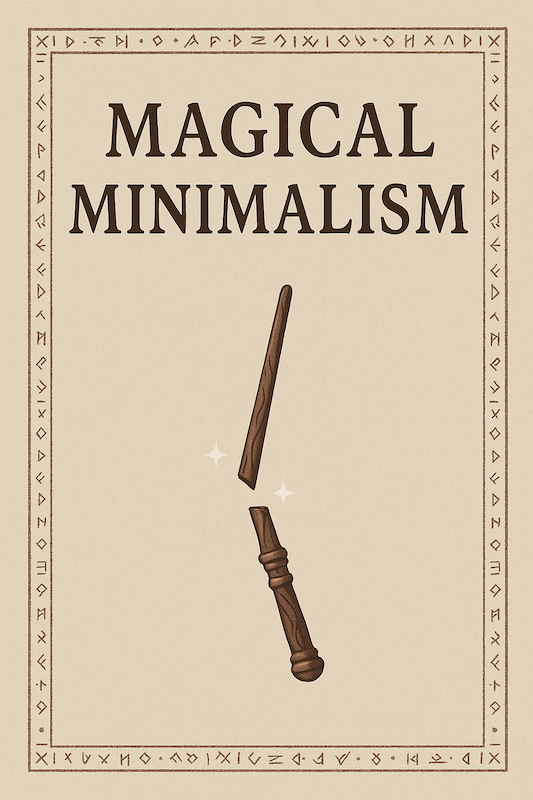Digital Minimalism by Cal Newport
by Željko Filipin
Estimated reading time is 9-12 minutes.

Introduction
Digital Minimalism is a very influential book for me. Out of Newport’s nine books, only Deep Work is more influential.
I have listened to the audiobook version in 2022. I have read the ebook version in 2025. I rate about one percent of the books I read with five stars. This is one of them. It’s also one of the very rare books that I want to read every few years.
Summary
The book paints a clear picture that we have a problem with the way we use technology today. It gives examples of problems. It provides explanations to what is causing the problems. Finally, it gives a solution on how to deal with the problem. The solution is digital minimalism, a philosophy of using technology with intention.
Talks
I talked about the book at a few events this month.
I gave a three minute lightning talk about it in front of almost three hundred coworkers. I haven’t been that nervous for a long time. I think it went well. I presented the book as a funny story about a world where everybody uses magic all the time, like we use technology.
I gave a talk about the book at a local parent’s meeting, in front of about twenty people. I think it also went well. I had ninety minutes and it was barely enough time. There were a lot of comments and questions.
I gave a five minute lightning talk at a local tech meetup. I totally messed it up. Lesson learned.
I gave a talk in front of about ten coworkers. Almost all slides were in Magical Minimalism style. I used ChatGPT and Picsart for generating images. I think it went well. I had sixty minutes and it was again barely enough time. There were a good amount of comments and questions.
I’ve proposed to lead a session about the book at an internal company conference in September 2025.
Magical Minimalism

I’m thinking about making a picture book called Magical Minimalism. It would be a story of a young wizard apprentice that starts to think that maybe everybody uses magic too much. If you would like to read the book, please let me know.
Popular Highlights
As usual when I read a Kindle book, I’ll comment on the popular highlights. It’s such a fascinating feature. There’s usually about ten popular highlights. It’s very interesting to see what other people highlighted.
… what you need instead is a full-fledged philosophy of technology use, rooted in your deep values, that provides clear answers to the questions of what tools you should use and how you should use them and, equally important, enables you to confidently ignore everything else.
(Introduction, page xiv, 2208 highlighters.)
Simple and quick tips and tricks don’t work. You need to get serious about this.
The tycoons of social media have to stop pretending that they’re friendly nerd gods building a better world and admit they’re just tobacco farmers in T-shirts selling an addictive product to children. Because, let’s face it, checking your “likes” is the new smoking.
(Chapter 1, A Lopsided Arms Race, page 9, 2632 highlighters.)
I’ve talked with a few parents. We all see the problems technology can introduce to our lives. We’re even more worried about the problems it can introduce in the young minds of our kids.
… how tech companies encourage behavioral addiction: intermittent positive reinforcement and the drive for social approval.
(Chapter 1, A Lopsided Arms Race, page 17, 3425 highlighters.)
Similar to the previous quote. It’s pretty bad for adults. It’s even worse for kids.
Digital Minimalism
A philosophy of technology use in which you focus your online time on a small number of carefully selected and optimized activities that strongly support things you value, and then happily miss out on everything else.
(Chapter 2, Digital Minimalism, page 28, 3569 highlighters.)
Of all the things I have heard so far about how to manage our digital lives, this is the only one that has a chance of success.
… minimalists don’t mind missing out on small things; what worries them much more is diminishing the large things they already know for sure make a good life good.
(Chapter 2, Digital Minimalism, page 30, 3913 highlighters.)
This book forces you to think hard about what you value in life. It’s not an easy task, but it’s one of the most important things you can do.
“The cost of a thing is the amount of what I will call life which is required to be exchanged for it, immediately or in the long run.”
(Quoting Walden by Henry David Thoreau)
(Chapter 2, Digital Minimalism, page 39, 4095 highlighters.)
This reminds me of a FIRE book I have read, Your Money or Your Life. We exchange precious little time we have on this planet for money. How much of this very limited resource do you want to exchange for money?
Solitude Deprivation
A state in which you spend close to zero time alone with your own thoughts and free from input from other minds.
(Chapter 4, Spend Time Alone, page 103, 2707 highlighters.)
We are a creature that evolved with plenty of time alone with its own thoughts. We need solitude. Current generation is the first one that can spend its entire life without even a second of solitude. There’s always a phone in your pocket that you can use so you don’t have to think.
Leisure Lesson #1: Prioritize demanding activity over passive consumption.
(Chapter 6, Reclaim Leisure, page 177, 3107 highlighters.)
People crave doing hard and meaningful things. For work and for leisure.
Leisure Lesson #2: Use skills to produce valuable things in the physical world.
(Chapter 6, Reclaim Leisure, page 182, 2750 highlighters.)
Creating something in the digital world can be deeply fulfilling. But, there is even a deeper feeling of satisfaction when we create something in the real world.
Leisure Lesson #3: Seek activities that require real-world, structured social interactions.
(Chapter 6, Reclaim Leisure, page 190, 2680 highlighters.)
There’s a reason team sports are so popular. We crave both physical activity and spending time with other people. In the real world.
Quotes
When I exported sections I highlighted in the book, I got a thirty nine page pdf file. I got curious. How many highlights do I usually have in a book? I found twelve Kindle books with highlights in my library. When I export highlights to pdfs, it’s usually five to fifteen pages. There were a couple of books with just one or two pages. Digital Minimalism is the winner with thirty nine pages. The second is Deep Work with thirty three pages. The third is Getting Things Done with fourteen pages. All three books with a lot of highlights were very influential on me. I have read all three of them multiple times.
Out of thirty nine pages of highlights, let me comment on just a few.
People don’t succumb to screens because they’re lazy, but instead because billions of dollars have been invested to make this outcome inevitable.
(Chapter 1, A Lopsided Arms Race, page 9.)
I think most of us understand this vaguely. But, when it’s written down explicitly, it’s shocking and eye opening.
The Digital Declutter Process
Put aside a thirty-day period during which you will take a break from optional technologies in your life. During this thirty-day break, explore and rediscover activities and behaviors that you find satisfying and meaningful. At the end of the break, reintroduce optional technologies into your life, starting from a blank slate. For each technology you reintroduce, determine what value it serves in your life and how specifically you will use it so as to maximize this value.
(Chapter 3, The Digital Declutter, page 60.)
I’m surprised this is not a popular highlight. This is probably the most important part of the book. The rest of the book paints a clear picture that there is a problem. This part offers a solution. Simple in principle, but not so easy to implement.
Much in the same way that the “innovation” of highly processed foods in the mid-twentieth century led to a global health crisis, the unintended side effects of digital communication tools—a sort of social fast food—are proving to be similarly worrisome.
(Chapter 5, Don’t Click “Like”, page 136.)
This is a genius analogy. Everybody knows that as tasty as fast food is, you should consume it very rarely. What we need to collectively realize is that digital fast food is as bad for us, if not worse.
… the psychological forces that lead us to compulsively use technology are typically best understood as moderate behavioral addictions—which can make technology very alluring when it’s around, but aren’t nearly as severe as chemical dependency.
(Chapter 6, Reclaim Leisure, page 167.)
Finally some good news. As addicting as technology is, it’s not as bad as some forms of addiction.
… “attention economy” describes the business sector that makes money gathering consumers’ attention and then repackaging and selling it to advertisers.
(Chapter 7, Join the Attention Resistance, page 215.)
In case you didn’t understand how multinational companies make money while you spend hours looking at a screen. This is how.
Feedback
Thank you for reading. If you want to stay in touch please use the feed or send me an email.
tags: book - drive - photo - productivity